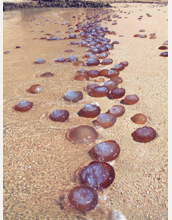Multimedia Gallery
Oman Jellyfish Swarm (Image 1)
Oman Jellyfish Swarm (Image 1)
Huge numbers of dead and dying jellyfish (Crambionella orsini) wash up in the shallow waters at Bandar Jissah, near Muscat in Oman in 2002. During this time period, there was a large proliferation of this species in the Arabian Sea, causing problems for fisherman and even fouling the water intakes of boats and power stations.
The jellyfish bloom--a dramatic increase in jellyfish population--was so large, that jellyfish were seen tumbling down the continental slope. Large aggregations of dead jellyfish were evident within canyons and on the continental rise. At the deepest stations, patches of rotting, coagulated jellyfish occurred. The patches were several meters in diameter, at least 7 centimeters thick and covered about 17 percent of the sediment surface. At other locations on the continental rise, the seafloor was covered in a thin, almost continuous layer of jelly "slime" a few millimeters thick, or was littered with individual jellyfish corpses.
Scientists are trying to learn more about the global movement of jellyfish--why non-native species may suddenly take root in a particular area, and also why are there sudden population explosions in parts of the world. Are they caused by human activities, climate change, ecological factors or are they a natural occurrence?
To learn more about the basics of jellyfish biology, what scientists have learned thus far about the worldwide increase in jellyfish populations, and the causes of jellyfish swarms and how they affect both human and marine life, see the NSF Special Report, "Jellyfish Gone Wild!" (Date of Image: 2002) [See related image Here.]
Credit: Dr. Fergus Kennedy, Indian Ocean Research and Conservation Association
Images and other media in the National Science Foundation Multimedia Gallery are available for use in print and electronic material by NSF employees, members of the media, university staff, teachers and the general public. All media in the gallery are intended for personal, educational and nonprofit/non-commercial use only.
Images credited to the National Science Foundation, a federal agency, are in the public domain. The images were created by employees of the United States Government as part of their official duties or prepared by contractors as "works for hire" for NSF. You may freely use NSF-credited images and, at your discretion, credit NSF with a "Courtesy: National Science Foundation" notation.
Additional information about general usage can be found in Conditions.
Also Available:
Download the high-resolution JPG version of the image. (3.5 MB)
Use your mouse to right-click (Mac users may need to Ctrl-click) the link above and choose the option that will save the file or target to your computer.

